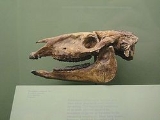
Parahippus
Encyclopedia
Parahippus is an extinct relative of the modern horse
, very similar to Miohippus
, but slightly larger, at around 1 metres (10 h) tall, at the withers
.
About 20 million years ago, during the Miocene
Period, the Earth was drastically changing: great plains were developing, forests were thinning out, mountains were forming, and swamps were drying up. It is believed these developments affected many changes in the existing horse ancestors.
to the big central toe. The side toes were almost vestigial, and seldom touched the ground.
Since leafy food had become scarce, these animals were forced to subsist on the newly-evolved grass
es that were by now taking over the plains, and their teeth adapted accordingly. The extra molar
crest that was variable in Miohippus became permanent in Parahippus. The molars developed high crowns and a hard covering for grinding the grass, which was typically covered with high-silica dust and sand.
Horse
The horse is one of two extant subspecies of Equus ferus, or the wild horse. It is a single-hooved mammal belonging to the taxonomic family Equidae. The horse has evolved over the past 45 to 55 million years from a small multi-toed creature into the large, single-toed animal of today...
, very similar to Miohippus
Miohippus
Miohippus was a genus of prehistoric horse existing longer than most Equidae. Miohippus lived in what is now North America during the Oligocene approximately 32-25 million years ago. While descending genera of this species lived during the Miocene period, the Miohippus was a horse of the Oligocene...
, but slightly larger, at around 1 metres (10 h) tall, at the withers
Withers
The withers is the ridge between the shoulder blades of a four-legged animal. In many species it is the tallest point of the body, and in horses and dogs it is the standard place to measure the animal's height .-Horses:The withers in horses are formed by the dorsal spinal processes of roughly the...
.
About 20 million years ago, during the Miocene
Miocene
The Miocene is a geological epoch of the Neogene Period and extends from about . The Miocene was named by Sir Charles Lyell. Its name comes from the Greek words and and means "less recent" because it has 18% fewer modern sea invertebrates than the Pliocene. The Miocene follows the Oligocene...
Period, the Earth was drastically changing: great plains were developing, forests were thinning out, mountains were forming, and swamps were drying up. It is believed these developments affected many changes in the existing horse ancestors.
Description
Parahippus was larger than Miohippus, with longer legs and face. The bones in the legs were fused and this, along with muscle development, allowed Parahippus to move with forward-and-back strides. Flexible leg rotation was eliminated, so that the animal was better adapted to fast forward running on open ground without moving from side to side. Most importantly, Parahippus was able to stand on its middle toe, instead of walking on pads, which gave it the ability to run faster; its weight was supported by ligaments under the fetlockFetlock
Fetlock is the common name for the metacarpophalangeal and metatarsophalangeal joints of horses, large animals, and sometimes dogs. It is formed by the junction of the third metacarpal or metatarsal bones proximad and the proximal phalanx distad...
to the big central toe. The side toes were almost vestigial, and seldom touched the ground.
Since leafy food had become scarce, these animals were forced to subsist on the newly-evolved grass
Grass
Grasses, or more technically graminoids, are monocotyledonous, usually herbaceous plants with narrow leaves growing from the base. They include the "true grasses", of the Poaceae family, as well as the sedges and the rushes . The true grasses include cereals, bamboo and the grasses of lawns ...
es that were by now taking over the plains, and their teeth adapted accordingly. The extra molar
Molar (tooth)
Molars are the rearmost and most complicated kind of tooth in most mammals. In many mammals they grind food; hence the Latin name mola, "millstone"....
crest that was variable in Miohippus became permanent in Parahippus. The molars developed high crowns and a hard covering for grinding the grass, which was typically covered with high-silica dust and sand.

